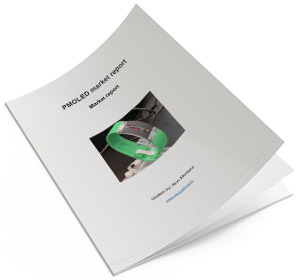OLED displays use organic materials that emit light when electricity is applied. OLEDs enable emissive, bright, thin, flexible and efficient displays. OLEDs are set to replace LCDs in all display applications - from small displays to large TV sets.
PMOLED: Passive Matrix OLED
PMOLED stands for Passive-Matrix OLED, which relates to the way you control (or drive) the display. A PMOLED display uses a simple control scheme in which you control each row (or line) in the display sequentially (one at a time). PMOLED electronics do not contain a storage capacitor and so the pixels in each line are actually off most of the time. To compensate for this you need to use more voltage to make them brighter. If you have 10 lines, for example, you have to make the one line that is on 10 times as bright (the real number is less then 10, but that's the general idea).
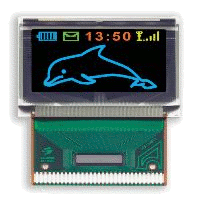 A PMOLED panel by Univision
A PMOLED panel by Univision
So while PMOLEDs are easy (and cheap) to fabricate, they are not efficient and the OLED materials suffer from lower lifetime (due to the high voltage needed). PMOLED displays are also restricted in resolution and size (the more lines you have, the more voltage you have to use). PMOLED displays are usually small (up to 3" typically) and are used to display character data or small icons: they are being used in wearable devices, small gadgets and sub displays
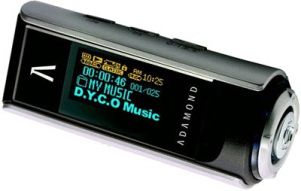
PMOLED vs AMOLED
The other kind of OLED display is called an AMOLED (or Active-Matrix OLED). An AMOLED uses a TFT that contains a storage capacitor which maintains the line pixels lit all the time (even though just one line is changed each time). AMOLEDs consume less power than PMOLEDs, have faster refresh rates and allows to build larger display with higher resolutions. AMOLEDs are also more complicated and expensive to fabricate.

AMOLEDs today are being used as displays for smartphones, digital cameras - and even OLED TVs.
Flexible and transparent PMOLEDs
Some small and simple flexible (conformable) PMOLED displays are already on the market. Japan's Futaba for example is producing several such displays, including a 1.4" 128x16 film PMOLED display adopted in several fitness bands from Garmin, HTC and others.
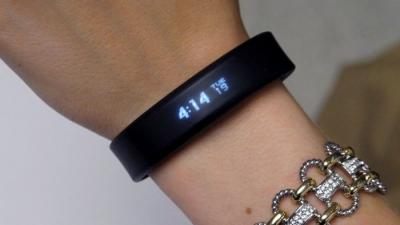
Transparent PMOLEDs are currently in development, with some segmented panels already on the market - but as of early 2018, no dot-matrix transparent PMOLEDs are available.
Looking for PMOLED suppliers?
Are you looking to adopt an PMOLED display for your device? Today there are several PMOLED producers (mostly in China and Taiwan), each making their own kinds of standard and custom PMOLED displays, with a total of dozens of different displays on the market.
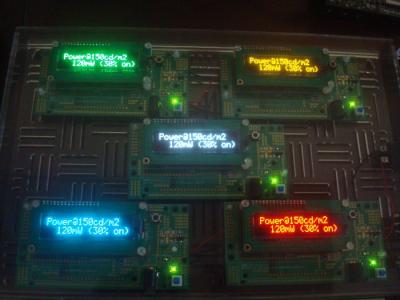
The OLED Marketplace is our very own comprehensive OLED catalog, in which you can find most of the PMOLED displays on the market. Click here to browse our extensive catalog.
The PMOLED Market Report
If you want to fully understand the PMOLED market and industry, check out our PMOLED Market Report. This comprehensive report explains:
- PMOLED production fabs
- Next-generation PMOLED technologies
- Flexible and transparent PMOLEDs
- PMOLED for automotive applications
The report package also provides datasheets and product catalogs and a detailed list of PMOLED producers.
Further reading
The latest PMOLED news:
Wisechip launches the world's first Hyperfluoresence OLED display - a 2.7" yellow PMOLED
Wisechip announced that it launched the world's first Hyperfluorescence OLED display - a 2.7" monochrome yellow 128x64 PMOLED. The brightness of this display reaches 220 nits - which is 2.5 times the brightness of Wisechip's fluorescent yellow PMOLED. The lifetime of this display is 50,000 hours.
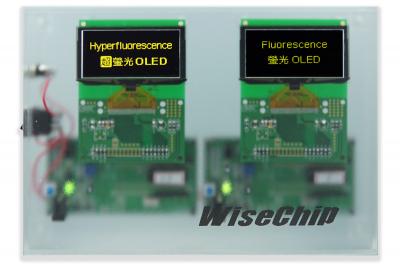
Hyperfluorescence OLED emitters represent the 4th-generation of OLED emitter systems. HF is an actually a system that combines fluorescence emitters (1st-gen) with TADF (3rd-gen) hosts - to achieve a high efficiency , long lifetimes and narrow-spectrum emission.
OLED-Info's foldable, flexible, VR/AR, transparent, microdisplays, PMOLED, automotive and graphene OLED market reports updated to July 2019
Today we published new versions of our market reports - that cover the flexible, VR/AR, microdisplays, automotive, PMOLED and graphene OLED markets. OLED-Info provides comprehensive niche OLED market reports, and our reports cover everything you need to know about the niche market, and can be useful if you want to understand how the OLED industry works and what this technology can provide for your own industry. The reports are now updated to July 2019.
 The Flexible and Foldable OLED Market Report:
The Flexible and Foldable OLED Market Report:
- Why flexible displays and lighting panels are so exciting
- What kind of flexible displays are currently on the market
- All about the foldable OLED market and industry
- What the future holds for flexible OLEDs
- How to acquire flexible OLEDs for your products
The report package provides a good introduction to the flexible and foldable OLED market - present and future. It details both flexible displays and lighting technologies. Read more here!
Wisechip's new 1.51" transparent PMOLED is available on the OLED Marketplace
Wisechip recently started shipping a new dot-matrix transparent PMOLED (1.51" 128x56, light-blue) and the display is now available on the OLED Marketplace. It's been many years since a standard dot-matrix transparent OLED was available, so this is great news.
If you are interested in this transparent display for your device or new project, contact us now, or check out more information over at the OLED Marketplace.
OLED-Info's foldable, flexible, VR/AR, microdisplays, PMOLED, automotive and graphene OLED market reports updated to April 2019
Today we published new versions of our market reports - that cover the flexible, VR/AR, microdisplays, automotive, PMOLED and graphene OLED markets. OLED-Info provides comprehensive niche OLED market reports, and our reports cover everything you need to know about the niche market, and can be useful if you want to understand how the OLED industry works and what this technology can provide for your own industry. The reports are now updated to April 2019.
 The Flexible and Foldable OLED Market Report:
The Flexible and Foldable OLED Market Report:
- Why flexible displays and lighting panels are so exciting
- What kind of flexible displays are currently on the market
- All about the foldable OLED market and industry
- What the future holds for flexible OLEDs
- How to acquire flexible OLEDs for your products
The report package provides a good introduction to the flexible and foldable OLED market - present and future. It details both flexible displays and lighting technologies. Read more here!
Kyulux's CEO shares company updates at OLED Korea 2019
In June 2018 Kyulux and Wisechip unveiled a PMOLED display that uses Kyulux’s Hyperfluorescence yellow emitter. Kyulux updated today that Wisechip is now ready to start producing the HF panel and is seeking customers.
Wisechip eventually settled on a large panel - 73.00 x 41.86 mm (2.7") with a resolution of 128x64. Wisechip says that the power consumption of its HF display is almost half of its regular fluorescent yellow PMOLED.
IHS: smartwatch display shipped soared from 9.4 million units in 2014 to almost 150 million in 2018
IHS says that recent years have seen a drastic growth in smartwatch shipments - the market grew from 9.4 million units in 2014 to 149 million units in 2018. In just one year, shipments grew 42% from 2017 to 2018.
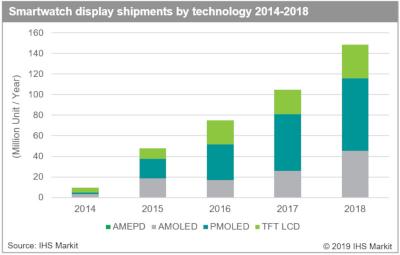
This rising demand for smartwatches has of course created a rising demand for displays. OLED displays are leading this segment - with around 80% of shipments in 2018 (the rest are mostly LCD displays). AMOLED display shipments were around 42 million and PMOLED shipments reached around 75 million.
Futaba's flexible 1.4" 128x16 PMOLED display now available on the OLED Marketplace
We are happy to announce that Futaba's film-type flexible 1.4"128x16 monochrome white PMOLED display has been added to the OLED Marketplace. This unique flexible PMOLED joins Futaba's 1.8" 160x32 white flexible PMOLED that is also available through the marketplace.
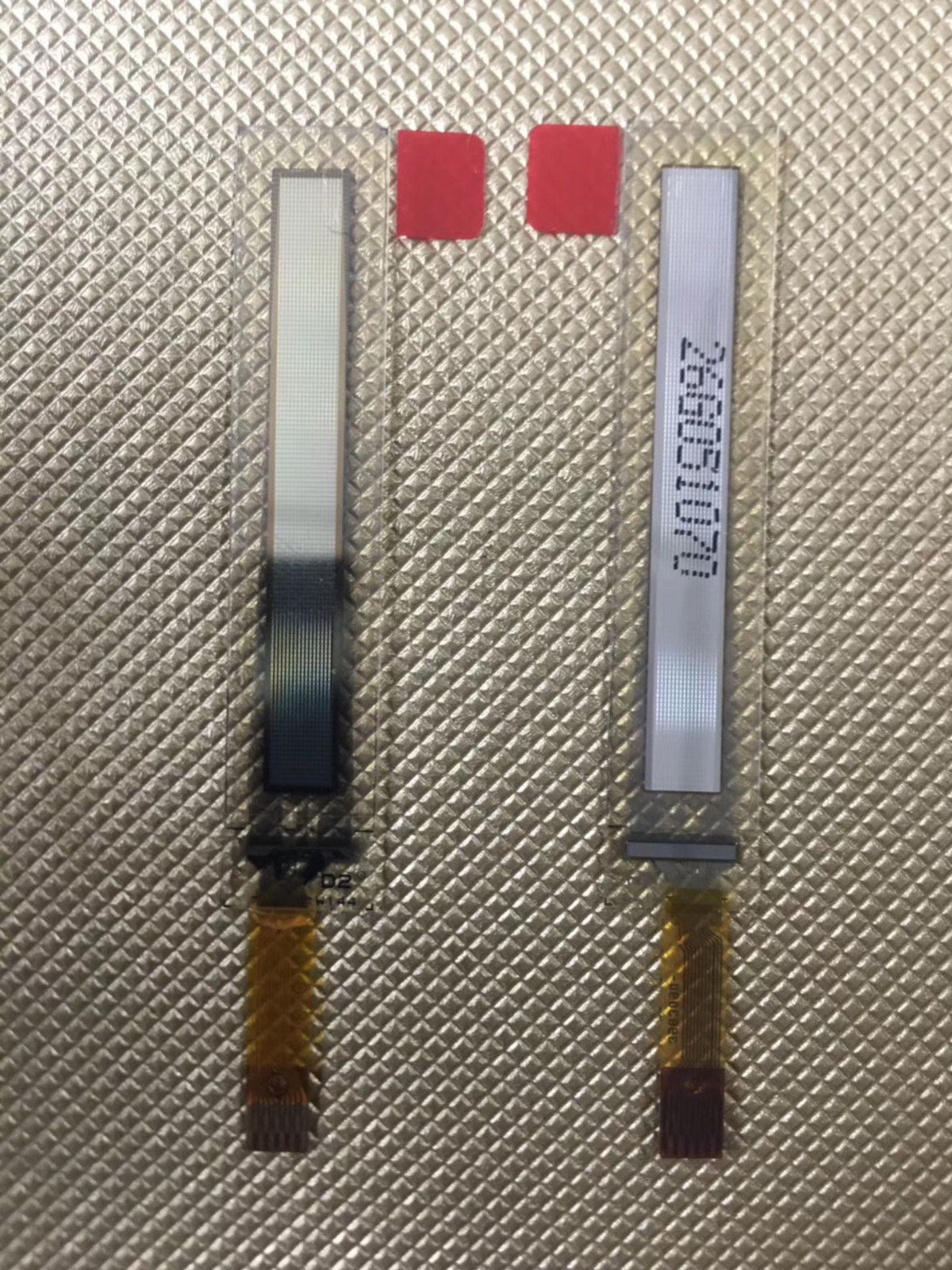
If you are interested in this display for your device or new project, contact us now, or check out more information over at the OLED Marketplace.
Samsung announces the Galaxy S10 (with 4 variants) and new OLED smartwatches
Samsung announced a handful of new devices, all with OLED displays. We'll start with the company's 2019 flagship smartphone, the Galaxy S10. It includes four different variants -
- Galaxy S10 5G: 6.7" 3040x1440 flexible AMOLED
- Galaxy S10+: 6.4" 3040x1440 flexible AMOLED
- Galaxy S10: 6.1" 3040x1440 flexible AMOLED
- Galaxy S10e: 5.8" 2280x1080 AMOLED (rigid?)
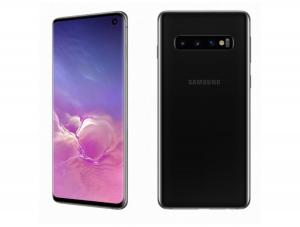
The S10 phones use Samsung's latest AMOLEDs, that are now HDR10+ certified, include an under-the-OLED fingerprint sensor (Qualcomm ultra-sonic) and cut-outs for the selfie cameras. Samsung calls these displays "Dynamic AMOLED" (due to the HDR support, probably) and "Infinity-O Display" due to the camera cut-outs.
Solomon Systech launches the world's first TDDI touch PMOLED IC
Solomon Systech launched a TDDI (Touch and Display Driver Integration) IC for PMOLED displays. The new SSD7317 (the world's first PMOLED TDDI IC) integrates touch and display microelectronics in a single chip and can enable thinner and lighter form factors and reduced manufacturing time and process - and higher display quality (higher light transmission) and touch performance.
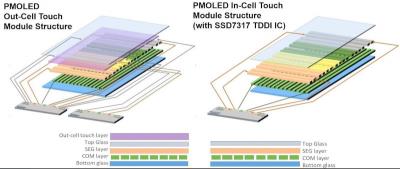
Solomon explains that the SSD7317 adopts a proprietary time multiplexing approach for display driving and in-cell touch detection, thereby enabling touch detection on traditional PMOLED display module with no modifications needed on the existing display module structure. Unlike traditional out-cell touch solutions (with separate display and touch IC) which need a dedicated ITO layer for touch sensor, the SSD7317 eliminates the touch ITO and PET substrate layers in addition to the bottom Optically Clear Adhesive (OCA).
Where are the transparent OLEDs?
Transparent displays are of great interest, and many envision a plethora of possible applications that use transparent screens in the retail, commercial and consumer markets. There are many exciting applications - but none with real and immediate demand.
Many OLED makers are developing transparent OLEDs, and in the past we've seen several producers that introduced such displays to the market - only to halt production a few months later. Device makers are on the lookout for such displays, and are still disappointed even though the technology is ready.
Pagination
- Previous page
- Page 4
- Next page
